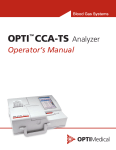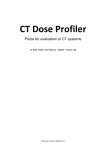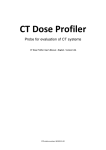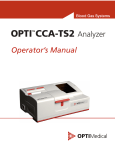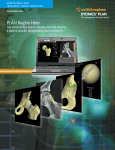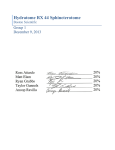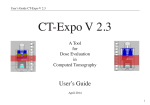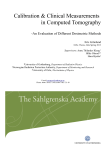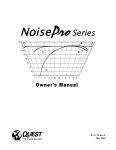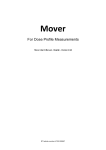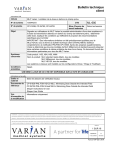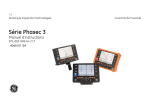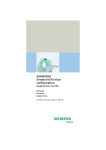Download PDF
Transcript
Documentation Summary CT-SD 16 Central Point Method 18 16 k=1,02 0 1 2 3 4 0 20 40 60 80 Time (s) 5 6 7 8 9 10,2 CT Dose Profiler 12 10 8 6 4 2 Dose (mGy) (C2-C1) 100 120 140 Z-axis (mm) 160 180 198,5 42,88 DLP (mGycm) 655 CTDIvol (mGy) CTDI100 (mGy) 36,6 CTDIw (mGy) 37,3 FWHM (mm) 24,6 Scatter index 1,09 130/100 38,5 l Smar l a m S curate c A e l b a ick Afford u Q t r a m S l mal ick Affordable Accurate S Ac k=CTDIw CTDI100,c ffor dab le 0 uic kA (mGy/s) 14 Ac e l b fforda A k c t Qui ar t m ll S a m te S a r cu Q RTI RTI Content Common User Question Revision D, May 2009 A summary of the most frequently asked questions about our CT Probes. Solid State CT Detector - Measurement Verification Revision D, May 2009 This report gives an overview of the documentation available concerning the correctness of the data measured with the Solid State CT Detector from RTI Electronics. Measurements on wide beam CT systems with no table movement Revision C, April 2009 This report is a case study of measurements on different types of CT systems with wide beams and no table movement. It explains the difficulties that the users are up against when using traditional measuring devices and procedures and what is required to do a correct measurement of the patient dose. The Energy Dependence of the CT Dose Profiler Revision C, April 2009 This report contains information of the energy dependence of the CT Dose Profiler from RTI Electronics. RTI Common User Question 1. Would you please compare CT Dose Profiler and DCT10 by feature and benefit. The largest difference between these two types of probes is that the CT Dose Profiler is a solid state detector whereas the DCT10 is an standard pencil ion chamber and they have therefore totally different ways of measuring the radiation that hits them. The DCT10 does not measure dose, it measures dose-time length during an axial scan and can therefore not be used to measure dose or dose rate to a point. Normally the chamber is only partly irradiated and can only measure beams that are maximum 100 mm wide (which is also the length of the chamber). It is less sensitive than the solid state detector and it can be harder to get stable values, especially when using a body phantom. The CTDI standard has been based on the use of CT ion chambers and axial scans but it have been shown that measurements during a helical scan using a point detector also gives the CTDI value required. The CT Dose Profiler measures dose (or dose rate) to a point and when you move it (using the table movement) it collects the dose profile. Therefore it has no limitation regarding the width of the beam. The software also calculates other useful data from the dose profile. We believe that the CTDI approach itself will disappear since new CT scanners have such wide beams that the 100 mm CT ion chamber cannot collect the complete dose contribution. 2. What are the different procedures of CT dose measurement between CT Dose Profiler and DCT10? With the CT Dose Profiler (and the CT-SD16) you measure during one scan in Helical (spiral) mode with the same protocol as is used for the patient. The software calculates CTDIvol and DLP, you get the true dose profile and can see the total dose even outside the 100 mm window. With the chamber DCT10, you have to make up to five axial scans and then manually calculate the CTDIvol and DLP. You will not get the dose profile and can very easily underestimate the dose to the patient. The time and the beam width cannot be measured since no spatial information can be acquired from the ion chamber. 3. What is the difference between measuring CTDIvol using the five phantom positions (A, B, C, D, E) and using the Central Point Method at only point A? In the standard procedure, the software uses the CTDI100 from all five phantom positions and calculated a weighted mean CT Dose Profiler 2009 value to get the CTDIvol. The “Central Point Method” uses the constant ratio (contant for each type of CT scanner and phantom size) between CTDIw and CTDI100. The software gives you CTDI100 in the central position . This value is then multiplied with the constant ratio (the k-factor) to give you CTDIw and CTDIvol. Read more about this in the user's manual. 4. Can the customers add their own data to the database? The CT database file can be updated/edited with new CT models. Normally that is done at RTI when a new releases is made. 5. How important is the beam quality when you make a free-in-air measurement? By selecting the correct beam quality (or the closest available beam quality), the energy correction for the detector is applied. For the CT Dose Profiler, the value is within 5% for the range of 60 to 150 kV for the RQR listed. For the CT-SD16 it could be more than 10%. 6. What is the best way to measure when the CT scanner isn't present in the database? Select a CT scanner similar to the one that you are going to perform the measurements on and change the name. 7. Why does the beam quality and k-factor only change when you double click on the database settings? Shouldn’t those settings change when you select a different CTunit or Phantom in the options below the database? Right now I can double click something in the database but if I change the phantom from body to head it won’t affect the beam quality or k-factor unless I use the database settings again That’s correct. The database is like a template and you can therefore use it for much more combinations that is in the database itself. Once you double click on a template from the database, you can change the name and other things but not the used beam quality or the k-factor since they are used to calculate the correct dose value. If the measurement is stored, the program uses the CT database index next time you read this file and use the same correction again a even if you have selected your own name of the CT system. Common User Question 1 Revision A, May 2009 RTI Solid State CT Detector Measurement Verification Solid State CT Detector - Measurement Verification Revision D, May 2009 This report gives an overview of the documentation available concerning the correctness of the data measured with the Solid State CT Detector from RTI Electronics. 1. Introduction. ................................................................................................................................................................................. 2 2. Comparison of dose profiles................................................................................................................................................ 2 2.1 The CT probe vs. TLD............................................................................................................................................................. 2 2.2 The CT probe vs. OSL............................................................................................................................................................. 3 2.3 The CT probe vs. Lic. .............................................................................................................................................................. 3 3. Comparison of CTDI.................................................................................................................................................................. 4 3.1 The CT probe vs. CT ion chamber................................................................................................................................... 4 3.2 Measurement comparison................................................................................................................................................. 4 4. Comparison of axial and spiral (helical) scans............................................................................................................ 5 4.1 Theoretical derivation........................................................................................................................................................... 5 4.2 Comparing measurements................................................................................................................................................. 6 5. Energy Dependence.................................................................................................................................................................. 6 6. Rotational symmetry................................................................................................................................................................ 6 7. Angular Dependence. .............................................................................................................................................................. 7 8. Conclusions.................................................................................................................................................................................... 8 9. References...................................................................................................................................................................................... 9 1 Solid State CT Detector - Measurement Verification Revision D, May 2009 RTI CT Dose Profiler 2009 1. Introduction Since the technique of using a solid state detector for measurements of the dose from CT scanners is brand new, verification of the method is needed. This report summarizes the results from comparisons with well-known techniques. The Solid State CT Detector (CT-SD16 or CT Dose Profiler) from RTI can be used as a substitute for the traditional pencil ionization chambers. Further on in the report it will be referred to as the CT probe. 2. Comparison of dose profiles The values measured with the CT probe are all derived from the measured dose profile. If we know that we get a correct dose profile, we can also trust the values that are derived from it. 2.1 The CT probe vs. TLD K. Perisinakis1 has compared dose profiles measured with a CT probe and a TLD array. The pictures below are from his work. Although the graphs in figure 1 contain very few data points, the profiles seem to coincide very well. Figure 1. Free-in-air dose profiles determined using TLD array (solid line) and the CT-SD16 detector (dotted line). The profiles were obtained using 120 kVp, small focus, and a head mode of operation. The twin vertical lines indicate the nominal beam width1. Figure 2 shows what typical dose profiles acquired free-in-air look like. These profiles also contain too few data points to show the profiles in detail. The numbers next to each profile represents the collimation (number of slices x width of each slice.) Figure 2. Free-in-air dose profiles determined using TLD array at 120 kV and all available beam collimations. The twin vertical lines indicate the nominal beam width1. Solid State CT Detector - Measurement Verification 2 Revision D, May 2009 RTI Solid State CT Detector Measurement Verification Figure 3 is a corresponding graph acquired with the CT Dose Profile Analyzer software. Here, the profile is represented by 640 samples. The collimation was in this case six millimeters. Figure 3. The profile measured with the CT Dose Profile Analyzer software. Here, the profile is represented with 640 data points. Read more about the new feature "Geometric efficiency" in the manual v4.0B. 2.2 The CT probe vs. OSL A way to acquire the dose profile within a phantom is by using an OSL dosimeter. This probe consists of an OSL-coated film substrate placed within a light-tight plastic cylinder. This cylinder can be inserted into a CTDI phantom. A single exposure is made with the patient table in stationary position. After exposure, the probe is returned to the manufacturer for reading with a precision laser. The result is a digital radiation dose profile that can be integrated to determine CTDI1002. There is an excellent agreement between the dose profiles generated by the OSL dosimeter and the CT-SD16 detector. 2.3 The CT probe vs. Lic Figure 4. Radiation profiles measured with the OSL dosimeter and the CT-SD16. The probes placed in air at the isocenter of the CT scanner (a). The probes are placed at the center of a CTDI head phantom (b)2. As part of a master thesis3, the CT probe was compared to a liquid ionization chamber (LIC). This chamber is able to measure dose profiles and has the same detector area length (0.3 mm) as the CT probe. The LIC and the CT probe were placed in a specially built 30 cm long PMMA phantom with a diameter of 160 mm. The phantom was positioned free in air, see figure 5. Figure 6. Dose profiles from the LIC and the CT probe normalized to a peak value of 1. 3 Solid State CT Detector - Measurement Verification Revision D, May 2009 Figure 5. The CT probe in a 30 cm long head phantom which was placed outside the table3 . A helical (spiral) scan with the same parameters was performed with each detector. The dose peak values were normalized to 1 for an easy comparison of the profiles, see figure 6. The area under the dose profile acquired with the CT probe was 1% smaller than the one measured with the LIC and the dose profiles coincide very well3. RTI CT Dose Profiler 2009 3. Comparison of CTDI When it comes to comparing the CTDIw (or CTDIvol) given by the CT modality (the consol) to the corresponding value given by the CT probe or an ion chamber, there is one thing to bear in mind. It is expected that these values do not coincide completely. In the IEC standard 60601-2-44 (2002) it is written that “The displayed CTDIvol given by the manufacturer represents a model and not the value measured on a particular CT scanner.” 3.1 The CT probe vs. CT ion chamber There are two things to be aware of when the CTDI measured with the CT probe is compared to the value measured with a CT ion chamber. For those who are using our first version of the probe, the CT-SD16, the correction of the angular dependence must be activated in the software. Otherwise the measured dose profile will be too low and as a consequence also the given CTDI value. The second thing is that some CT ion chambers have an energy dependence which is not flat over the kV-range when measuring in a CTDI phantom. The energy dependence of the CT probe is automatically corrected for in the software. 3.2 Measurement comparison A couple of examples of real life measurements can be seen in table 1, 2 and 3 below. This data was collected by the physicists at Linköping University Hospital. The CTDIvol was measured with the CT-SD16 and the CT Dose Profiler and compared to the value given by the CT consol. The CT scanner used was a Siemens Somatom Sensation Open. The measurements were performed in a body phantom using the protocol “abdomen routine”. The set kV was 120 kVp, the mAs was 200 and the tube rotation time was 1 second, FOV body. Siemens Somatom Sensation Open Collimation CT-SD16 CT Dose Profiler Value given by the CT consol 6 mm 14,0 14,2 18,22 12 mm 18,1 17,4 21,72 17 16,5 17,94 28.8 mm Table 1. A comparison of CTDIvol (mGy) measured with the CT-SD16, the CT Dose Profiler and the CT scanner. The measurements were performed at Linköping University Hospital. Also, the CTDIvol was measured at a GE Lightspeed Ultra using the CT Dose Profiler and a pencil ion chamber. These values were compared to the value given by the CT consol. The measurements were performed in a head phantom using the protocol “head routine”. The set kV was 120 kVp, the mAs was 200 and the tube rotation time was 0.5 seconds, FOV head. GE Lightspeed Ultra Collimation CT Dose Profiler Pencil ion chamber Value given by the CT consol 20 mm 19,6 21,43 19,14 15 mm 25,4 27,08 24,6 10 mm 25,4 27,40 25,01 5 mm 1.25 mm 32 34,27 31,32 25,9 29,02 27,07 Table 2. A comparison of CTDIvol (mGy) measured with the CT Dose Profiler and a pencil ion chamber in a head phantom. The measurements were performed at Linköping University Hospital. The same comparison was done using a body phantom using the protocol “abdomen standard”. The set kV was 120 kVp, the mAs was 200 and the tube rotation time was 0.5 seconds, FOV body. GE Lightspeed Ultra Collimation 20 mm CT Dose Profiler Pencil ion chamber Value given by the CT consol 9,34 10,75 9,64 15 mm 12,1 13,25 12,49 10 mm 12,1 14,10 12,72 5 mm 15,3 17,21 16,08 13 14,53 13,9 1.25 mm Table 3. A comparison of CTDIvol (mGy) measured with the CT Dose Profiler and a pencil ion chamber in a body phantom. The measurements were performed at Linköping University Hospital. Solid State CT Detector - Measurement Verification 4 Revision D, May 2009 RTI Solid State CT Detector Measurement Verification 4. Comparison of axial and spiral (helical) scans Traditionally, the CTDI100 has been measured during an axial scan with a 100 mm pencil ion chamber. It is however also possible to also measure the CTDI100 during a spiral (helical) scan as is required when using the CT probe. 4.1 Theoretical derivation Based on the assumption that the dose rate in the point of measurement is independent of the position of the tube, the dose from a complete rotation can be expressed as the signal Q per sample time ts multiplied by the rotation time F and a calibration factor c which converts Q(z) to D(z), the dose3. See equation 1. 1. Q(z)•F [Gy] ts D(z) = c For one axial scan, CTDI is defined as the integral of the dose profile along the rotational axis divided by the total nominal beam collimation3. This is expressed in equation 2. ∞ D(z) dz[Gy] 2. CTDI = ∫ Nd -∞ The total nominal beam collimation is N, the number of simultaneously acquired images, multiplies with the nominal beam width d. Combining equation 1 and 2 gives: ∞ ∞ Q(z)•F 1 c 3. CTDI = Nd ∫ D(z)dz [Gy] = -∞ ND - ∫∞ ts dz[Gy] The CT probe samples the signals on its way through the radiation field. After every sampling time ts and sampling length Δz, a signal Qi is collected which represents the dose in that part of the z-axis. The integral can be changed to a sum of all signals per sampling time3: Qi c F 4. CTDI = ∑ Nd i ts Δz [Gy] Δz is the distance between two sample points and it depends on the table speed T and on the sampling time3. 5. Δz = T • ts Combining this with equation 4 gives: 6. CTDI = The pitch is defined as: 7. p = TF Nd cFT ∑ Q [Gy] Nd i i Also, if n is the number of samples made during 100 mm then CTDI100 can be given by: 8. CTDI100 = pc n ∑ Qi [Gy] i=1 The CTDI100 can be measured during a helical scan if the collected signal ΣQi over the distance 100mm is multiplied with the calibration factor c and the pitch p. Measurements in the central hole in a phantom fulfils the assumption that the dose rate is independent of the pitch3. 5 Solid State CT Detector - Measurement Verification Revision D, May 2009 RTI CT Dose Profiler 2009 4.2 Comparing measurements Dose profiles from helical scans and axial sequential scans measured with the CT probe were compared, see figure 7. The area under the dose profile differed with 1.02% between the two methods3. Figure 7. Dose profiles acquired with the CT probe during a helical scan and during axial sequential scans. 5. Energy Dependence The energy dependence of the CT Dose Profiler is corrected for automatically in the software. To read more, see further in this documentation. 6. Rotational symmetry The detector chip inside the CT probe is rotational symmetric. This is very important since we want to exclude that variations in the reading of the beam intensity during the rotation is related to the probe itself. Figure 8 shows the result of a typical test of a CT Dose Profiler made at RTI Electronics. The deviation between min and max dose rate is in this case 2.1 percent. However, since we have a falling load during the exposure, the actual deviation during the rotation is even smaller. Figure 8. The maximum deviation from max to min signal during a rotation must be within 5% .In this example it is 2.1%. Solid State CT Detector - Measurement Verification 6 Revision D, May 2009 RTI Solid State CT Detector Measurement Verification 7. Angular Dependence The angular dependence refers to the change in signal when the probe is not aligned with the table, see figure 9. Figure 9. Testing the angular dependence. In our first version of the CT probe, the CT-SD16, the software contains a correction for the angular dependence of the detector chip. Without this correction, the signal would change in the way as can be seen in figure 103. When using the CT-SD16 for measuring CTDI, this correction is automatically applied to the profile. However, if point doses are measured (during an axial scan) the correction is not applied. Figure 10. The angular dependence of the CT-SD16 (without the correction applied). The left part of the graph represents the side of the connector side of the chip and the right side represents the front part of the chip. Figure 11. The angular dependence of the CT Dose Profiler. The detector chip inside the second version of the probe, the CT Dose Profiler, is more or less independent of the angle of radiation and in that sense more similar to an ion chamber. Figure 11 and 12 show the angular dependence of the CT Dose profiler and a CT ion chamber (from Victoreen.) Since no software correction needs to be applied when using the CT Dose Profiler, it makes it more suitable for measuring point doses. Figure 12. The angular dependence of a standard 100 mm pencil ion chamber (from Victoreen). 7 Solid State CT Detector - Measurement Verification Revision D, May 2009 C RTI CT Dose Profiler 2009 8. Conclusions • The conclusion from this report is that the solid state CT probe from RTI Electronics can be used as a substitute for the standard 100 mm pencil ion chamber. • The dose profile measured by the CT probe is very similar to the profile measured with TLDs, OSL and a liquid ion chamber. Since all data given by the software is derived from the dose profile, we can thereby conclude that they are derived from a correct measurement. • The CTDI100 measure with the CT probe is comparable with CTDI100 measured with a pencil ion chamber. • The procedure to measure in a helical scan instead of an axial scan gives the same CTDI value. • The CT probe is rotational symmetric and independent of the beam energy and angulation since this is taken care of by the software. Read more about the corrections applied to the measurements in chapter 12 in the CT Dose Profile Analyzer Manual4. 9. References 1. K. Perisinakis, “The effect of x-ray beam quality and geometry on radiation utilization efficiency in multidetector CT imaging”, Med. Phys. 36 (4), April 2009. 2. J. A. Bauhs, T. J. Vrietze, A. N. Primak, M. R. Brusdewitz, C. H. McCollough, “CT Dosimetry: Comparison of Measurement Techniques and Devices”, RadioGraphics 2008; 28;245-253 3. B. Cederquist, “Evaluation of two thin CT profile detectors and a new way to perform QA in a CTDI head phantom”. Master Thesis in Radiation Physics at Göteborg University. 4. CT Dose Profile Analyzer Manual, version 4.0B. Contact y QA e X-ra v i t a v o Inn Contact World Headquarters RTI Electronics AB Phone: + 46 31 746 36 00 Flöjelbergsgatan 8 C Fax: + 46 31 27 05 73 SE-431 37 Mölndal E-mail: [email protected] SWEDEN www.rti.se ... ons i t u Sol US Office RTI Electronics, Inc. 1275 Bloomfield Avenue Building 5, Unit 29A Fairfield, NJ 07004 USA Phone: 800-222-7537 Phone: 1-973-439-0242 Fax: 1-973-439-0248 E-mail: [email protected] Solidwww.rtielectronics.com State CT Detector - Measurement Verification 2 Revision A, May 2009 ! rse u o of C RTI RTI Measurements on wide beam CT with no table movement Measurements on wide beam CT systems with no table movement Revision C, April 2009 This report is a case study of measurements on different types of CT systems with wide beams and no table movement. It explains the difficulties that the users are up against when using traditional measuring devices and procedures and what is required to do a correct measurement of the patient dose. 1. Introduction. ................................................................................................................................................................................. 2 2. Measurements with a standard CT pencil ion chamber....................................................................................... 3 2.1 To measure CTDI...................................................................................................................................................................... 3 2.2 To measure the dose to a point....................................................................................................................................... 6 3. Measurements with the CT Dose Profiler.................................................................................................................... 8 3.1 To measure CTDI...................................................................................................................................................................... 8 3.2 To measure dose to a point............................................................................................................................................... 8 4. Conclusions................................................................................................................................................................................. 10 5. References................................................................................................................................................................................... 10 In this paper we will refer to the first version of our CT Slice Detector as CT-SD16 and second version of the detector as CT Dose Profiler (released in 2009). 1 Measurements on wide beam CT systems with no table movement Revision C, April 2009 RTI CT Dose Profiler 2009 1. Introduction CT systems with very wide beams (larger than 10 cm) and no table movement have been developed from two different directions. From one direction we have the very fast 320 Multi Slice CT from Toshiba which has a tube rotation time of 3 turns per second. When the slice width is more than 64 slices, the table does not move anymore. From the other direction we have the medical linear accelerator therapy units, which are combined with a Cone beam CT unit. In these systems, imaging data is typically acquired in a 200 or 360 degree rotation and a full rotation takes up to two minutes. The beam widths are about 15 cm wide and the table position is fixed. Unlike conventional CT scanners the X-ray beam is pulsed. How is the CTDI100 supposed to be measured on these types of CT units where the minimum collimation is as wide as the length of the CT ion chamber? The CT Dose Profiler and the CT-SD16 are options but how can they be used when there is no table movement? And what are the values given by the manufacturer that we compare our results to? And the most important question; how can we get a good estimation of the dose given to the patient? The measurements referred to in paper have been performed on a Varian Clinac IX at the Sahlgrenska University Hospital in Göteborg, Sweden, on a Elekta Synergy (X-ray Volumetric Imager (XIV) Cone Beam System) at Rikshospitalet in Oslo, Norway and on a Toshiba Aquilion 320 at Toshiba, Japan. Measurements on wide beam CT systems with no table movement 2 Revision C, April 2009 RTI Measurements on wide beam CT with no table movement 2. Measurements with a standard CT pencil ion chamber 2.1 To measure CTDI CTDI100 was introduced in 1995 as a practical indicator of the patient dose. The wide spread use of the 100 mm pencil chamber seems to have been an temporary solution that became the standard. This chamber measures the accumulated dose in a phantom in a series of consecutive scans covering a specific scan length of L = 100 mm. So, what is the problem with CTDI100? It underestimates the dose for typical clinical body scan length of 250–500 millimeter1. Already at a beam width of 20 millimeter when measuring in a phantom, the complete scatter tails become too long to be measured by the pencil chamber. The picture below shows a dose profile acquired from a 64 Slice CT with the CT Dose Profiler and the CT Dose Profile Analyser software. The collimation (the beam width) is 40 millimeter and the detector is placed in a CTDI body phantom. The measured dose rate values within the red dotted cursors, separated by 100 millimeter, are integrated to give CTDI100. However, when then green (c1) and blue (c2) cursor are placed at the positions where the profile is reduced to zero, we see that the value between these cursors CTDI (c2-c1) is 14.8 mGy compared to the value of CTDI100 which is 11.1 mGy. The ratio between these CTDI values is given as the parameter Scatter ratio (c1–c2)/100. In this measurement with 40 millimeter wide beam, the scatter tails introduce 33 percent more dose than a pencil chamber can measure. Further description of the software and how to interpret the dose profile is found in chapter 3. Figure 1. The dose profile from a scan in the central position in a body phantom in a 64 Slice CT. 3 Measurements on wide beam CT systems with no table movement Revision C, April 2009 RTI CT Dose Profiler 2009 Whether or not the parameter CTDI100 can be used as a predictor of the clinical patient dose has been under debate for some time1. To measure with the standard pencil chamber may be complicated and full of pitfalls that the standard user may not be aware of, especially when measuring on CT systems that were not available when the chamber (nor CTDI) was invented. Problem 1: The beam width For example, in the Elekta Synergy, the smallest possible beam width is 10 cm. When a standard CTDI measurement is performed with a pencil ion chamber the width of the beam is the same as the active length of the chamber. The tails of the scattered radiation introduced in a phantom (or a body) at this beam width is much wider and the ion chamber will under-estimate the patient dose1. Problem 2: Phantom length In order to use the parameter CTDI in the calculation for the total dose given to the patient, all the dose during one axial rotation should all be contained within the length of the chamber. Our measurements show that at least two phantoms were needed to cover the whole width of the dose contribution in the head phantom. For the body phantom, at least three were required3. According to Dixon1 the required lengths are 180 and 300 mm respectively. The same measurement as in figure 1 was performed with three body phantoms in a row. The dose contribution from the scatter tails have increased to 71% compared to CTDI100. Figure 2. The dose profile from a scan in the central position in a composition of three body phantoms in a 64 Slice CT. Measurements on wide beam CT systems with no table movement 4 Revision C, April 2009 RTI Measurements on wide beam CT with no table movement In figure 3, the result of the same measurement performed in a composition of five body phantoms is shown. The dose contribution from the scatter tails is now 76% higher compared to CTDI100. Since the scatter contribution differs little between three and five phantoms, we conclude that three phantoms are required to include all dose contribution. Figure 3. The dose profile from a scan in the central position in a composition of five body phantoms in a 64 Slice CT. The five phantoms mounted together. Problem 3: You cannot measure dose free in air To measure the dose free in air on a Multi-detector CT with a pencil chamber correctly, you need to know the projection of the collimation. In other words, the true width of the beam that hits the patient, the beam FWHM. The standard way is to calculate CTDIair by dividing the measured integral with the collimation T but the factor that should be used instead is the FWHM. For Multi-Detector CT, the FWHM is greater than T. There is a penumbra beyond the active detectors to ensure that they are fully irradiated. For example, on a GE Lightspeed 16 Slice scanner, the CTDIair is 27% greater than the actual “in air” central ray dose for T=10mm and 56% larger for T=5 mm. The true dose is essentially constant for the different collimator settings1. 5 Measurements on wide beam CT systems with no table movement Revision C, April 2009 RTI CT Dose Profiler 2009 2.2 To measure the dose to a point Absorbed dose is a measure of the energy deposited to a unit mass of absorbing material. In this paper we will refer to the absorbed dose as the point dose. According to the definition of CTDI, it describes the summation of all those dose contributions along a line which is parallel to the axis of rotation of the scanner (z-axis)2. If we go back to the basics, maybe we can use the point dose instead to estimate the patient dose. Problem 4: No peak dose data When doing a measurement of the dose to small volume (organs) with the pencil chamber, you perform a single axial rotation with the chamber centred (z = 0) inside a phantom. By moving the chamber to the different positions in the phantom, you acquire measured data from both the peripheral and central holes. This leads to the incorrect conclusion that the dose from this single axial rotation is the same, regardless of which hole it is measured in. The peak dose rate during a rotation is very dependent on where in the phantom the detector is placed. With the pencil chamber an integral over the total rotation is measured and it cannot differentiate between a narrow profile (with high peak dose) or a broad profile (with low peak dose) if they have the same area. The peak dose rate can be very important to know since it is the dose rate that may for example hit the eye of a patient during a CT scan1. Figure 4 shows how the dose rate is distributed in the central phantom position (body) during one axial on a GE Lightspeed 64 Slice CT. The table attenuation is the explanation of the dip. The integrated dose is 2.76 mGy and the maximum dose rate is 2.97 mGy/s. In the central phantom position the peak dose rate is approximately the same as the integrated dose. This is because the amount of filtration is similar from all directions during the rotation. Figure 4. The dose distribution during one axial scan in the central hole. Measurements on wide beam CT systems with no table movement 6 Revision C, April 2009 RTI Measurements on wide beam CT with no table movement Figure 5. The dose distribution during one axial scan in a peripheral hole. The same exposure but in a peripheral phantom position shows us a very different result, see figure 5. Here, the average dose is 9,75 mGy and the peak dose rate is 53,3 mGy/s, that is 18 times higher than in the central hole. During the rotation, when the tube is in the position closest to the detector, the beam is hardly filtrated at all, giving this high peak dose rate. By measuring the point doses at different positions along the z-axis keeping the x and y positions the same, you can get an average dose in this plane1. However, since an ion chamber integrates the total dose it detects, the sum will look the same in a peripheral hole as in the central hole, since it gives the mean value of the whole rotation. The data from the exposure cannot be investigated at a certain point. See further how this can be done in chapter 3.2. 7 Measurements on wide beam CT systems with no table movement Revision C, April 2009 RTI CT Dose Profiler 2009 3. Measurements with the CT Dose Profiler 3.1 To measure CTDI To be able to measure the CTDI with the CT Dose Profiler (or CT-SD16), a table movement is required. During the scan through the beam, the thin detector (250µm) collects the total dose profile and the CT Dose Profile Analyzer software gives the dose profile. From this profile, all parameters are calculated, such as CTDI100 but it is also possible to set the cursors anywhere in the profile, allowing the CTDI being calculated at any length (even to include the complete scatter tails also). See figure 1 for the required dose profile. In our study, since the X-ray units don’t have any table movement, we created a movement of the probe by connecting it to a motor. The motor pulled the probe through the phantom with a constant speed. We want to stress that this motor is not available as a product, it was only used during this investigation. Figure 6 shows this type of measurement performed on a Toshiba Aquilion 320 using a total phantom length of 820 mm and a collimation of 160 mm. Each dip you see in the dose profile is when the tube goes underneath the table, in other words, one turn. Dickson has done the same type of measurement in his study using a small ion chamber (0.6 cc Farmer) and simulated an ion chamber of appropriate length1. The corresponding measurement on the Varian Clinac IX Cone beam CT can be seen in figure 7. The profiles are a bit similar but for this Cone beam CT, the peaks are not the turns of the CT tube, they are a result of the pulsed output from this machine. In fact, almost the whole profile is acquired during one turn (tube rotation time 60s). Figure 6. Measuring CTDI on the Toshiba Aquillon 320 Slice CT. Figure 7. Measuring CTDI on the Varian Clinac IX Cone Beam CT. 3.2 To measure dose to a point The point dose can very easily be measured with the CT Dose Profiler. The diode is rotational symmetric in the x-y plane and it has negligible angular dependence in the z-direction which is important in order to measure dose to a point. We recommend to use the CT Dose Profiler for this type of measurements since the CT-SD16 has an angular dependence. The software will give the dose contribution on a graph on a time scale. The peak value or the summarized contribution from one turn can be read out. If the X-ray generator has pulses they are seen and the pulse frequency and pulse length can be checked. In figure 8 to the right, we have the scan from one axial rota- Figure 8. The dose distribution from the Varian Clinac IX during one axial scan in the central hole. Measurements on wide beam CT systems with no table movement 8 Revision C, April 2009 RTI Measurements on wide beam CT tion in the Varian Clinac IX. The CT Dose Profiler is placed in the centre of the phantom. The dip in the right part of the profile is because of the table attenuation. If the collection time is reduced to 1 s, the pulses can be resoluted, see figure 9. The measurement was performed when the tube was above the table. The average dose rates (in figure 8 and 9 this value is found in the display called “Average (mGy/s) range (C1 to C2)”) between the two pictures coincide (0.34 and 0.36 mGy/s) if we set the cursors as in figure 8 and calculate the mean dose value on the same part of the rotation. In figure 8, the maximum dose rate value is approximately 0.5 mGy/s and that is not corresponding to the maximum value of almost 2.75 mGy/s in figure 9. The explanation is that because a limited amount of samples (the memory depth of the electrometer) the graph can not resolute each individual peak when the exposure time is as long as 60 s and the result is a mean value. However, when we have a shorter time, each pulse is displayed correctly. The peak dose rate in the central phantom position is found to be 2.75 mGy/s, more than 7 times higher than the average dose rate. Figure 10 below, shows the same type of measurement as in fig 7 performed in a peripheral phantom position. Again the average dose rate is fairly constant at 0.38 mGy/s. To see the true peak dose rate we collect data during a short period, see figure 11. It is not possible to compare the average dose rate values between figure 10 and 11 since the level of the output is very varying compared to the measurement in the central position. We managed to capture the highest part of the profile. Here we have a peak dose rate of 22 mGy/s and the average dose rate is still 0.38 mGy/s. The peak dose rate is almost 60 times higher than the average dose rate in a peripheral phantom position. with no table movement Figure 9. The pulsed output can be seen if the data is collected during one second. Figure 10. The dose distribution during one axial scan in a peripheral hole. The output from this CT is pulsed as can be seen in the dose profile. Figure 11. The dose distribution during one axial scan in a peripheral hole. The output during one second. 9 Measurements on wide beam CT systems with no table movement Revision C, April 2009 C RTI CT Dose Profiler 2009 4. Conclusions There is no easy solution to measuring the patient dose on wide beam CT systems yet. The most convenient way is to measure the point doses at different positions and thereby create a mean value of the dose given to the patient. Remember to use enough phantom length. It is easy to be tricked by the manufacturers CTDI data. When doing a standard CTDI measurement with a pencil chamber the result may be very similar to the result given by the manufacturer. Remember that they also might have been doing the same type of measurement so what you are comparing is not the total dose given to the patient. The mean value of the total absorbed dose measured with the CT Dose Profiler was compared to the reading of TLDs and the deviation was within the uncertainty of the measurements (±10%)3. 5. References 1. R. L. Dixon, “Restructuring CT Dosimetry – A realistic strategy for the future Requiem for the pencil chamber” Med Phys. 33 (10), October 2006 2. H. D. Nagel, “Radiation Exposure in Computed Tomography” 3. Å. Palm, E. Nilsson, “Absorbed Dose and Dose Rate using Varian OBI 1.3 and 1.4 CBCT system”. To be published. Contact y QA e X-ra v i t a v o Inn Contact World Headquarters RTI Electronics AB Phone: + 46 31 746 36 00 Flöjelbergsgatan 8 C Fax: + 46 31 27 05 73 SE-431 37 Mölndal E-mail: [email protected] SWEDEN www.rti.se US Office RTI Electronics, Inc. 1275 Bloomfield Avenue Building 5, Unit 29A Fairfield, NJ 07004 USA Phone: 800-222-7537 Phone: 1-973-439-0242 Fax: 1-973-439-0248 E-mail: [email protected] www.rtielectronics.com ... ons i t u Sol ! rse u o of C RTI RTI The Energy Dependence of the CT dose Profiler The Energy Dependence of the CT Dose Profiler Revision C, April 2009 This report contains information of the energy dependence of the CT Dose Profiler from RTI Electronics. 1.1 Definition of Beam Qualities We made the comparison for beam quality RQR which is defined in the IEC report 61267 Medical diagnostic X-ray equipment – Radiation conditions for use in the determination of characteristics. In addition, we also used beam quality RQT. Beam Quality kV HVL (approximate values) RQR 4 60 2,12 RQR 6 80 3,02 RQR 8 100 4,0 RQR 9 120 5,02 RQR 10 150 6,63 RQT 9 120 8.4 Table 1. The kV and HVL of the beam qualities investigated in this paper. RQR is the family of beam qualities that is used in conventional radiography without any added filtration. RQT is a quality that simulates the filtration added when a measurement is done inside a CT phantom. It gives a corresponding HVL value. We chose the test the energy dependence only at RQT 9. The energy dependence is displayed in terms of energy correction factors, that is if this the factor is multiplied with the measured dose if the detector, the detector will have no energy dependence. 1 The Energy Dependence of the CT Dose Profiler Revision C, April 2009 C RTI CT Dose Profiler 2009 1.2 The energy correction of the CT Dose Profiler The CT Dose Profiler was compared to a reference ion chamber at PTB for the determination of its energy correction. The result can be seen in figure 1 and table 2 The energy dependence is very small, especially compared to other uncertainties involved in CT measurements. The energy correction factors have been added to the software and they will be automatically applied to the measured result. Figure 1. The energy correction of the CT Dose Profiler compared to the reference chamber at PTB. Beam Quality CT Dose Profiler RQR 4 1,031 RQR 6 0,966 RQR 8 0.965 RQR 9 1.0 RQR 10 1.082 RQT 9 0,998 Energy Correction of the CT Dose Profiler 1.100 1.050 kQ RQR RQT 1.000 0.950 0.900 3 4 5 6 7 8 9 10 11 RQR/RQT Contact y QA e X-ra v i t a v o Inn Contact World Headquarters RTI Electronics AB Phone: + 46 31 746 36 00 Flöjelbergsgatan 8 C Fax: + 46 31 27 05 73 SE-431 37 Mölndal E-mail: [email protected] SWEDEN www.rti.se Table 2. The energy correction of the CT Dose Profiler compared to the reference chamber at PTB ... ons i t u Sol US Office RTI Electronics, Inc. 1275 Bloomfield Avenue Building 5, Unit 29A Fairfield, NJ 07004 USA Phone: 800-222-7537 Phone: 1-973-439-0242 Fax: 1-973-439-0248 E-mail: [email protected] www.rtielectronics.com The Energy Dependence of the CT Dose Profiler 2 Revision C, April 2009 ! rse u o of C RTI Scandinavian Quality SINCE 1981 RTI Electronics was founded in 1981 when several curious and enterprising students met at Chalmers University of Technology in Gothenburg, Sweden. They saw their vision grow into the beginning of RTI products – today world leading in X-ray QA and Service instrumentation. There are many reasons why RTI Electronics has become a market leader. Besides fulfilling the highest user demands, products from RTI Electronics are known for cutting edge innovation. Other reasons include our engagement, our expertise accumulated over more than a quarter of a century, and our commitment to doing it right. We are convinced that You will be satisfied with Your choice of product, and we would like to continue to grow – together with You. © Copyright 2009 RTI Electronics AB – CT Dose Profiler SUMMARY 200905 World Headquarters RTI US Office RTI Electronics AB Phone: + 46 31 746 36 00 Flöjelbergsgatan 8 C Fax: + 46 31 27 05 73 SE-431 37 Mölndal E-mail: [email protected] SWEDEN www.rti.se RTI Electronics, Inc. 1275 Bloomfield Avenue Building 5, Unit 29A Fairfield, NJ 07004 USA Phone: 800-222-7537 Phone: 1-973-439-0242 Fax: 1-973-439-0248 E-mail: [email protected] www.rtielectronics.com
























